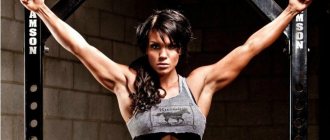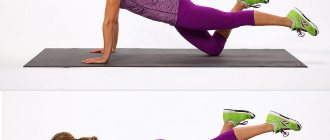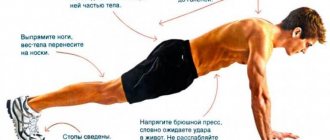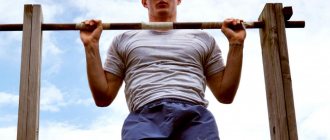What you need to learn to do pull-ups
It would seem that pulling up is associated only with lifting your own body. But even this fact requires compliance with certain conditions, ignoring which can significantly complicate the task.
So, you can learn to do 20 pull-ups or more if you:
- no excess weight;
- developed back and shoulder muscles;
- no back pain.
In addition, a warm-up should precede the execution of the element. Also, to achieve the desired result, you must follow the rules, including:
- Strong grip on the bar and no sudden movements
- Direction of gaze and chin up
- Maintaining uniform speed when ascending and descending
- No holding your breath
Important : any lifting of the body over the bar consists of four phases, each of which takes a certain percentage of time. Maintaining these proportions is an important key to success.
| Element phase | Percentage of time |
| climb | 35 |
| fixation | 15 |
| descent | 35 |
| pause | 15 |
In addition, if you are wondering how long it takes to learn how to do pull-ups from scratch, then you should know that:
- there is no need to force things and give yourself excessive stress - improving quality is always better than increasing quantity;
- increasing the number of repetitions and approaches should be gradual - this also applies to exercises leading to the main element;
- To get the desired result, you need to train the whole body by performing related exercises.
Follow all these rules and you will succeed. After all, as Vincent Lombardi said:
“God gave you a body that can endure almost anything! Your task is to convince your mind of this!”
What exercises are needed to learn how to do pull-ups?
In order to learn how to do more pull-ups at home, you need to approach the process smoothly. Start with regular push-ups - this way you will strengthen and prepare the muscles of your back and shoulders for the main goal.
And 3 simple elements will help speed up the process itself:
1. Hold
Jump onto the horizontal bar using some kind of hill. In this case, the chin should be in the upper position. Hold this position for as long as possible, tensing your back muscles.
2. Reverse action
We also jump into the top position, but stay there for just a second. The task is to slowly lower yourself to the starting position.
3. Horizontal pull-ups
To perform the element, any stick thrown between the chairs is suitable. You need to crawl under the stick and grab it, while placing your body parallel to the floor. With your heels on the floor and leaning back, you need to pull your chest towards the bar.
Learning to do pull-ups from scratch at home
Pull-ups are an exercise from the school curriculum, and it is not for nothing that it is included in it, as it allows you to assess the level of physical development of a person. However, many people cannot do even one pull-up. And there’s nothing wrong with that - it’s never too late to master pull-ups on the horizontal bar from scratch. There are many effective methods on how to do this.
Before each lesson, be sure to warm up. It requires only a little time, but significantly reduces the risk of injuries and sprains, warms up the muscles and prepares them for the upcoming loads.
You can learn how to do pull-ups on a horizontal bar from scratch at home , without outside help. Since full pull-ups are only in front, only the phase of the exercise called negative, namely lowering down, will be used.
You need to place a chair (stool, platform or any other elevated place) behind the bar so that you can easily rise and fall on the horizontal bar. Stand on a hill, grab the bar with an overhand grip (palms facing away from you) with your hands shoulder-width apart. Bend your elbows and keep your chin slightly above the bar. Hang in this position for a couple of seconds. Now smoothly and slowly straighten your arms and, resisting your own weight, lower your body down. Rest for a few seconds, then repeat the exercise. In total, try to do 5-6 approaches with a forward and reverse grip. With a reverse grip, your palms are facing you.
This diagram of pull-ups on the horizontal bar from scratch will allow you to learn how to do pull-ups in just a week . If before you couldn’t do a single pull-up, now you can easily repeat the exercise several times. Try not to stop there. For example, at the beginning of your workout, you can do three sets of full pull-ups as many times as you can, and then move on to the negative phase of slowly lowering your weight.
Do you want to become a fitness trainer from scratch? Read here how to do it!
Another option , how to start doing pull-ups on the horizontal bar from scratch, involves having a partner help you. You need to grab the bar with a straight or reverse grip with your hands shoulder-width apart and hang on it. Bend your knees and cross them at calf level.
Your task is to try to pull yourself up, your partner’s task is to hold your legs and, with little effort, help you rise up. In this way, it will take on some of your weight, making the exercise easier. Try to lower yourself slowly, avoid jerks and sudden falls.
After a few workouts, you will be able to do pull-ups yourself, without an assistant. These two methods are the most effective for mastering pull-up exercises on a horizontal bar from scratch. In just a week you can learn how to do this.
How to do pull-ups on the horizontal bar correctly
Before we talk about how to learn how to do a lot of pull-ups on the horizontal bar and what exercises are needed for this, you need to master the correct technique for performing the element.
So, let’s divide the execution technique into three periods:
1. Beginning
Place your hands on the horizontal bar slightly wider than shoulder width or shoulder width apart. Wrap your fingers tightly around the bar. Squeeze your shoulder blades, pull in your stomach, straighten your body. Make sure to keep your neck tucked into your shoulders and your shoulders down. Your arms should be completely straight. In this case, you need to constantly keep your back tense. The body should not sag. It is from this position that we begin our ascent.
2. Middle of the exercise
As you inhale, slowly lift your body up, placing your chin over the bar. Don't forget to watch your shoulder blades. They need to be pulled back and down as the elbows move towards the ribs.
3. The very top
Once your chin is above the bar, you don’t need to immediately drop down. Hold for a few seconds. At the same time, try to pull your chin even more and squeeze your shoulder blades. The abs and buttocks should remain tense. Make sure that your shoulders do not move forward in front of the horizontal bar.
Correct execution of the element excludes:
- swaying and writhing of the body;
- deflection of the lower back and arching of the back;
- pressing the head into the shoulders and straining the neck.
Pull-up techniques
If you have already figured out the technique, then you can diversify the program for pulling up on the horizontal bar from scratch with various variants of this exercise. The following techniques exist:
- Wide grip pull-ups. When performing this type of pull-up, your arms are positioned approximately shoulder-width apart, your elbows are down, and your body is slightly leaning forward. When performing lifts, fix your torso in a flat horizontal position. A wide grip allows you to work the latissimus dorsi muscles. Close-grip pull-ups work the biceps to a greater extent.
- Overhand grip pull-up. Recommended for beginners, as it harmoniously works the main muscle groups of the back, arms, and chest. When doing this, your hands are shoulder-width apart, your legs are bent at the knees. The fixed point of lifting will be touching the bar with the pectoral muscles, then you can lower down, relaxing and straightening your arms.
- Reverse grip pull-up. Also a good technique for beginners, in which you need to grab the bar, placing your hands in front of your body at a fairly close distance from each other. Pull yourself up until your chest touches the horizontal bar.
- One arm pull-up. This is a rather complex exercise that can only be done by those who have mastered other types of pull-ups and have fairly strong arms. You should start doing it by placing your free hand on the wrist of the hand that is located on the horizontal bar. Then the free hand needs to be gradually moved upward - to the forearm, biceps, and then the shoulder. It is very important to adhere to consistency, to do everything carefully and smoothly.
How to learn to do a lot of pull-ups on the horizontal bar: scheme of actions
To master pull-ups from 0 you need to do the following:
1. Set a goal
Those. if you want to do 10 pull-ups in 15 days, write about it.
2. Make a clear action plan
It should include everything: from lead-in exercises and their technique to the number of approaches and training regimen.
3. Do at least one pull-up correctly.
Only after you have mastered the correct execution of the element can you move on and increase the number of repetitions.
4. Increase the number of repetitions evenly
Add at least one repetition every day.
For beginners, you can propose the following scheme for achieving your goal, say, in one month:
| Day, week | Action |
| First day | Hanging on a bar, imitation of a pull-up, consisting of a slight lifting of the body with a delay at the top point. |
| First week | Full pull-ups with the support of a partner or with support on a stool. |
| Second week | A negative variation of the element that places the main emphasis on the descent technique. We need to take a position as if we had pulled ourselves up and begin a slow descent. |
| Third week | Alternate exercises from the first and second weeks. |
| Fourth week | Full pull-ups with a gradual increase in the number of repetitions to achieve your goal. |
What equipment can be used
In addition to using a stool or other elevated position, you can use auxiliary equipment to make the task easier, including TRX loops and an expander. Loops perform well when working with your own weight and allow you to master the element even faster.
Learning to pull yourself up with an elastic band
Expanders or rubber loops are widely used in mastering pull-ups. There is even a whole technique for performing an element with their help.
The technique consists of attaching one end of the elastic band to the crossbar and securing the other to one or two legs. The expander will take on part of the exerciser’s weight and help lift the body up.
To achieve maximum effect, you need to try your best, doing the last repetition at the limit of your ability. As soon as doing pull-ups with an elastic band seems easy, move on to performing a regular element. With the help of an expander, you can master both narrow and wide grip.
More information in the video:
How to teach a girl to do pull-ups on the horizontal bar from scratch
It’s not only the stronger sex that can pull themselves up. A girl can do this too. The element allows you to pump up many muscle groups, so it leaves no one indifferent.
The technique for women is the same as for men, but the number of repetitions may be less.
Important! Since strong arms are needed to perform the element, it is necessary to first strengthen the muscles.
Both push-ups from the floor and their lighter version – push-ups from the wall will help with this.
How can a child master lifting his body over the bar?
Learning to lift your body over the bar is not just for adults - girls and boys can also master the element well. And a parent or coach will help them with this.
Based on the fact that the reverse grip is easier to start with. First you need to support the child and give him the opportunity to catch up. Don’t take all the work on yourself - let the little athlete also strain.
The next step will be mastering the descent. And then there is an increase in the number of repetitions.
In the following video, dad clearly shows how he taught his son to do pull-ups:
Set your records
For many, after mastering the correct technique, excitement is triggered: is it possible to learn how to do pull-ups many times in a minimum amount of time or do this the maximum number of times. Let's go through the records!
How to easily master pull-ups in 2 weeks
The program is suitable only for those who already know how to do push-ups without difficulty. We divide two weeks into 7 workouts, between which there must be rest days.
1. First week
We strengthen the muscles of the chest, arms and back with push-ups according to the following scheme:
| Day | Action |
| First | 100 push-ups in two sets |
| Second | rest |
| Third | four sets of 20-30 push-ups 2 times a day (between sets there should be a rest of 2-3 minutes, the number of push-ups should be as maximum as possible) |
| Fourth | rest |
| Fifth | eight sets of 20 seconds twice a day (within 20 seconds you need to do a maximum of push-ups, 10 seconds of rest are given between sets) |
| Sixth | rest |
| Seventh | 100 push-ups in two sets, but you need to spend at least a third less time than it was on the first day |
2. Second week
The push-ups themselves according to the following scheme:
| Day | Action |
| First | Negative pull-ups on a low bar (5-6 sets of 6-8 repetitions) |
| Second | rest |
| Third | Regular pull-ups with different grips (after choosing the most comfortable grip, do three sets to the maximum) |
| Fourth | rest |
| Fifth | Lifting the body with weights (we hang a backpack with a heavy object on our shoulders and do 3-4 approaches with it to the maximum) |
| Sixth | rest |
| Seventh | rest |
If necessary, you can repeat this two-week marathon again to learn how to do a lot of pull-ups on one arm.
Learn to do pull-ups in a week
Below is a diagram of mastering 10 pull-ups in a week:
| Day | Action |
| First | Five approaches 1-2 times with a minute and a half rest between them |
| Second | Do one repetition, then 2 and so on, reaching your maximum and resting 10-15 seconds between sets. |
| Third | 3 sets with a regular grip, resting a minute in between, then 3 sets with a close grip. |
| Fourth | Do as many reps as possible and as many sets as you can, resting one minute in between. |
| Fifth | Choose the most difficult day and repeat it morning and evening |
| Sixth | rest |
| Seventh | Increase the maximum possible number of repetitions and approaches by 1 |
If you find it difficult to master the program the first time, you can start it again.
How to master 100 pull-ups at a time
Is it possible to do 100 pull-ups at a time? If you set a goal for yourself, then this is achievable! The main thing is to adhere to the following tips:
1. Be sure to warm up before training to avoid injury, and do not neglect the cool-down
2. Use special gloves
3. Don’t exercise if you’re feeling unwell.
4. Do aerobic exercise to strengthen your heart and respiratory system.
You also need to pay attention to individual characteristics. For example, with a weak hand, it is better to increase the tempo, which is not suitable for weak breathing. Makes it easier to find the most comfortable grip. A slow pace is suitable for those with strong biceps and brachioradialis.
To achieve the desired result, it is better to train twice a day: before lunch and before dinner using the ladder method (increasing the number of repetitions to the maximum with each approach).
Basic mistakes
There are factors that interfere with the process of mastering the projectile. These include:
- Excess weight. If you are overweight, more muscle effort is required to pull up. If your weight exceeds the norm by 20 kilograms or more, then first of all you need to get your shape in order.
- Problems with the cardiovascular system. In a person with a weak heart and blood vessels, when performing an exercise, the blood simply does not have time to pass through the narrow capillaries. As a result, the pressure jumps, the head feels dizzy, and the vision becomes dark. Agree, this greatly interferes with the normal flow of training.
- Poor physical shape. Pull-ups are not given to those who do not have endurance and physical strength.
- Muscle weakness. When performing an exercise, various muscle groups are involved; if some of them are too weak, mastering the exercise may be in question. The success of the event largely depends on the training of small auxiliary muscles, which are not strong enough for most novice athletes.
- Incorrect execution. Pull-ups on a horizontal bar are a complex technique that has its own rules. If you do not take this point into account, you can simply try to sway and shake your body a lot in the hope of getting results. Of course, nothing will work out.
- Lack of practical skills, which leads to inconsistency in the functioning of the nervous and muscular systems. Due to lack of practice, the muscles start working late and inconsistently, although they receive commands from the central nervous system. How to fix it? Train, but only do it according to all the rules.











